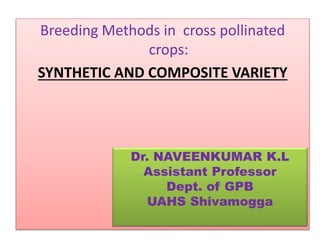
18. synthetics and composites
- 1. Breeding Methods in cross pollinated crops: SYNTHETIC AND COMPOSITE VARIETY Dr. NAVEENKUMAR K.L Assistant Professor Dept. of GPB UAHS Shivamogga
- 2. What is synthetic variety? A variety which is developed by inter-mating in all possible combinations a number of inbred lines with good general combining ability and mixing their seeds (seeds of F1s) in equal quantity is referred to as synthetic variety. VARIETY: in plant breeding, a strain released for commercial cultivation by a variety release committee. It is relevant to cross pollinated species. The commercial utilization of synthetics varieties in maize was first suggested by Hays and Garber (1922).
- 4. Why synthetic varieties are developed? The basic concept in the development of synthetic variety is exploitation of heterosis. In the development of synthetics, heterosis is partially exploited, because some degree of inbreeding takes place due to open pollination in later generations. What is genetic constitution of a synthetic variety? Initially, a synthetic variety consists of several heterozygotes. A synthetic variety is maintained by open pollination, some degree of selfing occurs resulting in fixation of some genes. As a result in later generations, a synthetic variety consists of several heterozygotes and homozygotes.
- 5. Main features of synthetic variety 1. They are relevant to cross pollinated species. 2. They are maintained by open pollination. 3. They exploit more of additive variance. 4. In later generations, they consist of several heterozygotes and homozygotes. 5. Synthetics have wider adaptability. 6. Synthetic varieties exploit more of additive gene action than dominance gene action. 7. Generally, 5-8 good general combining inbred lines are used to constitute a synthetic variety. 8. A synthetic variety can safely be grown for a period of 4-5 years without reduction in yield potential.
- 11. Synthetic 2 (Syn2) performance depends on 1. The number of parental lines (Syn0 population) constituting the synthetic. 2. On the differences in yielding ability of Syn1 and Syn0 generation. Syn1 is the first generation synthetic produced by mating in all possible combinations the n parental lines. This relationship was first suggested by Sewall Wright (1922). Where, n is the number of parental lines entering the synthetic variety. The performance of Syn3 and the subsequent generations obtained by random mating is expected to be comparable to that of Syn2, provided contamination by foreign pollen and inbreeding are avoided. Available evidence shows that the above formula estimates the yield of Syn2 populations quite reliably. Syn2 = Syn1 – [(Syn1 – Syn0) / n]
- 12. Factors determining the performance of Synthetic varieties
- 15. Achievements Synthetic varieties have been developed in cross pollinated crops like maize, pearl millet, sunflower, sugarbeet, alfaalfa, lucerne and several other crops in USA. In India, synthetic varieties have been developed in pearl millet at ICRISAT and in sugarbeet at Pantnagar university. In sugarbeet- Pant synthetic 3 In cauliflower- synthetic 3
- 16. Composites Concept originated in India. Generally derived from varietal crosses in advanced generations. Developed from OPV or heterozygous populations or germplasm (not subjected to inbreeding/combining ability tests). The composites often show higher heterosis in F1’s when widely diversed populations are used. GCA and additive gene affects play predominant role in exploitation of these populations Reconstitution is not possible Composites may serve as a base population for developing inbred lines
- 17. Procedure Screen diverse germplasms by evaluation at multilocations to identify the sources having adaptability, desirable agronomic traits and resistance to major diseases and pests. I Year: Making all possible crosses among selected superior genotypes and harvesting crossed seed separately. II Year: Evaluation of F1 crosses in replicated trail using hybrid or open pollinated variety as check. III to IV Year: Evaluation of F2 , F3 and F4 generations replicated trail using standard check, identification of crosses exhibiting little or no inbreeding depression. VI & VII Year: Mixing parental seed of superior crosses in equal quantity to constitute composite variety , seed multiplication by open pollination in isolation. VIII Year: Release of new composite variety
- 18. Achievements Several composite varieties have been developed in maize in India. The important varieties are Jawahar, Vijay, Kisan, Amber, Sona, Vikram, Protina, Rattan, Shakti, Vikas, Tarun, Renuka, Kanchan, Co 1 etc In Brassica compestris var toria an early maturing variety known as composite 1 has been released.
